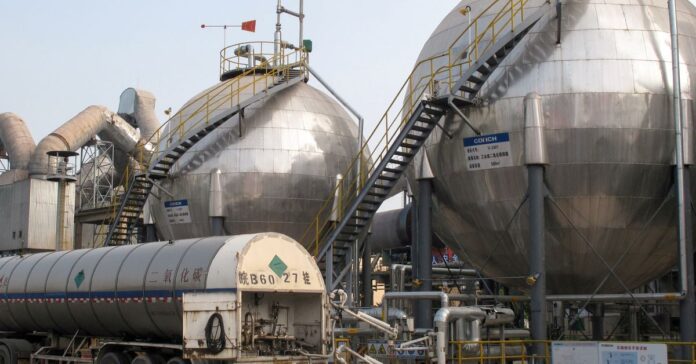Nov 22 (Reuters) – Applied sciences that seize carbon dioxide emissions to get them from the ambiance are central to the native local weather applications of many world governments as they see to look at through on world commitments to decarbonize by mid-century.
Furthermore they’re expensive, unproven at scale, and may moreover simply moreover be laborious to advertise to a nervous public – making unworkable, in the interim, the model envisaged worldwide of capturing carbon and storing it for cash.
As worldwide places accumulate for the Twenty eighth United Nations native local weather swap conference throughout the United Arab Emirates on the destroy of November, the search recordsdata from of carbon seize’s future function in a neighborhood climate-friendly world will in all probability be in focus. Listed below are some particulars regarding the bellow of the {industry} now, and the obstacles throughout the association through which of celebrated deployment:
FORMS OF CARBON CAPTUREThe most general manufacture of carbon seize skills includes capturing the fuel from some extent supply like an industrial smokestack. From there, the carbon can both be moved within the current day to everlasting underground storage or it’s going to moreover simply moreover be venerable in a single different industrial motive first, diversifications which are respectively often called carbon seize and storage (CCS) and carbon seize, utilization, and storage (CCUS).
There are at present 42 operational business CCS and CCUS initiatives internationally being able to retailer 49 million metric a whole bunch carbon dioxide as quickly as a 12 months, mainly based completely on the World CCS Institute, which tracks the {industry}. That’s set 0.13% of the world’s roughly 37 billion metric a whole bunch annual vitality and industry-connected carbon dioxide emissions.
Some 30 of those initiatives, accounting for 78% of all captured carbon from the neighborhood, train the carbon for enhanced oil restoration (EOR), whereby carbon is injected into oil wells to free trapped oil. Drillers suppose EOR can accumulate petroleum extra native climate-friendly, however environmentalists suppose the discover is counter-productive.
The diversified 12 initiatives, which fully retailer carbon in underground formations with out utilizing them to boost oil output, are throughout the U.S., Norway, Iceland, China, Canada, Qatar, and Australia, mainly based completely on the World CCS Institute.
It is unclear how fairly a lot of those initiatives, if any, flip a revenue.
One different manufacture of carbon seize is insist air seize (DAC), whereby carbon emissions are captured from the air.
About 130 DAC firms are being deliberate across the area, mainly based completely on the World Vitality Firm (IEA), although simply 27 had been commissioned and so they seize simply 10,000 metric a whole bunch carbon dioxide as quickly as a 12 months.
The U.S. in August introduced $1.2 billion in grants for 2 DAC hubs in Texas and Louisiana that promise to seize 2 million metric a whole bunch carbon per 12 months, although a last funding decision on the initiatives has not been made.
HIGH COSTS[1/3]Carbon dioxide storage tanks are thought-about at a cement plant and carbon seize facility in Wuhu, Anhui province, China eleventh of September, 2019. REUTERS/David Stanway/File Guidelines Rep Licensing Rights
One stumbling block to quickly deployment of carbon seize skills is be acutely aware.
CCS prices fluctuate from $15 to $120 per metric ton of captured carbon wanting on the emissions supply, and DAC initiatives are an extended far more expensive, between $600 and $1,000 per metric ton, because of the quantity of vitality wished to seize carbon from the ambiance, mainly based completely on the IEA.
Some CCS initiatives in worldwide places like Norway and Canada had been paused for financial causes.
Builders suppose they need a carbon be acutely aware, both throughout the manufacture of a carbon tax, buying and selling design or tax destroy, that makes it profitable to seize and retailer the carbon. With out that, best carbon seize initiatives that stretch revenue in a selected association – like through elevated oil output – are profitable.
Nations together with the U.S. preserve rolled out public subsidies for carbon seize initiatives. The Inflation Discount Act, handed in 2022, affords a $50 tax credit score rating per metric ton of carbon captured for CCUS and $85 per metric ton captured for CCS, and $180 per metric ton captured through DAC.
Although these are essential incentives, firms should peaceable wish to rob on some added prices to go CCS and DAC initiatives ahead, acknowledged Benjamin Longstreth, world director of carbon seize on the Horny Air Task Drive.
Some CCS initiatives preserve additionally did no longer present out the talents’s readiness. A $1 billion conducting to harness carbon dioxide emissions from a Texas coal plant, for example, had persistent mechanical problems and mechanically neglected its targets sooner than it was shut down in 2020, mainly based completely on a chronicle submitted by the conducting’s homeowners to the U.S. Division of Vitality.
The Petra Nova conducting restarted in September.
LOCATION, LOCATION, LOCATIONWhere captured carbon may moreover simply moreover be stored is restricted by geology, a actuality that may grew to become extra pronounced if and when carbon seize is deployed on the extra or a lot much less big scale that may in all probability be wished to construct up a distinction to the native local weather. The acceptable storage websites for carbon are in elements of North The US, East Africa, and the North Sea, mainly based completely on the World CCS Institute.
Which method getting captured carbon to storage websites may effectively require intensive pipeline networks and even supply fleets – posing potential modern obstacles.
In October, for example, a $3 billion CCS pipeline conducting proposed by Navigator CO2 Ventures throughout the U.S. Midwest – alleged to go carbon from heartland ethanol vegetation to glorious storage websites – was canceled amid concerns from residents about potential leaks and constructing damage.
Firms investing in carbon removing wish to rob severely neighborhood concerns about modern infrastructure initiatives, acknowledged Simone Stewart, industrial coverage specialist on the Nationwide Wildlife Federation.
“Not all utilized sciences are going to be doable in all places,” Stewart acknowledged.
Reporting by Leah Douglas
Enhancing by Marguerita Choy
Our Requirements: The Thomson Reuters Perception Rules.
Washington-basically based completely award-successful journalist overlaying agriculture and vitality together with competitors, legislation, federal companies, firm consolidation, environment and native local weather, racial discrimination and labour, beforehand on the Meals and Environment Reporting Community.

